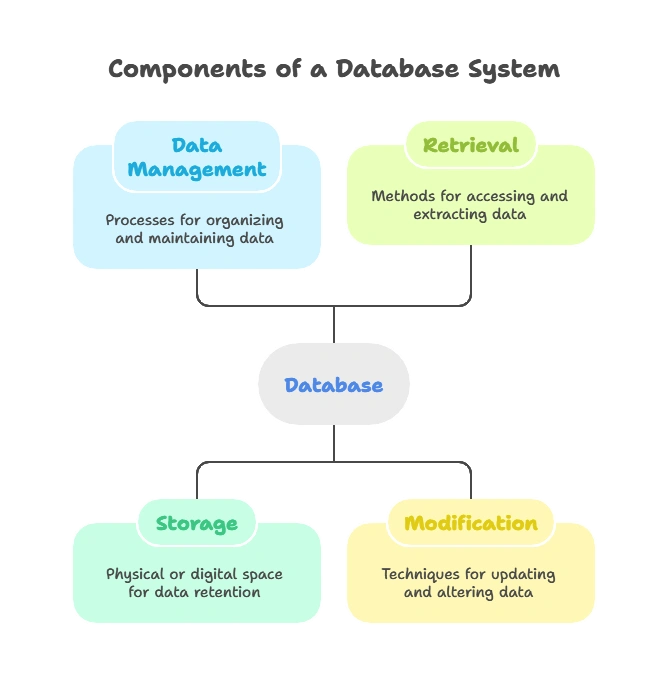Introduction to Databases
Databases are the backbone of modern applications, storing and organizing data in a way that allows for efficient retrieval and manipulation. This chapter will introduce you to databases, covering basic to advanced concepts, types of databases, their components, operations, and more. By the end of this chapter, you'll have a thorough understanding of databases and how they work.
What is a Database?
A database is an organized collection of data, typically stored and accessed electronically from a computer system. Databases allow for the efficient management, storage, retrieval, and modification of data.

Types of Databases
Databases can be classified into several types based on their structure and functionality. The most common types are relational, NoSQL, and NewSQL databases.
Relational Databases
Relational databases store data in tables with rows and columns. Each row represents a record, and each column represents a field within the record. These databases use Structured Query Language (SQL) for data manipulation.
Example: MySQL, PostgreSQL
NoSQL Databases
NoSQL databases are designed to handle large volumes of unstructured or semi-structured data. They are more flexible than relational databases and can store data in various formats such as key-value pairs, documents, graphs, or wide-column stores.
Example: MongoDB, Cassandra
NewSQL Databases
NewSQL databases combine the scalability of NoSQL databases with the ACID properties of relational databases. They are designed to handle large-scale data while maintaining consistency and reliability.
Example: Google Spanner, CockroachDB
Database Management Systems (DBMS)
A Database Management System (DBMS) is software that interacts with the user, applications, and the database itself to capture and analyze data. It provides tools for data definition, manipulation, and control.
Example: Oracle, Microsoft SQL Server, MongoDB
Components of a Database
Databases consist of several key components:
- Tables/Collections: Where data is stored.
- Schemas: Define the structure of the database.
- Indexes: Speed up data retrieval.
- Queries: Commands to retrieve or manipulate data.
- Transactions: Ensure data integrity.
Database Models
Different database models define how data is structured and managed.
Hierarchical Model
Data is organized into a tree-like structure. Each child record has only one parent.
Network Model
Data is organized into a graph structure with multiple parent and child relationships.
Relational Model
Data is stored in tables with rows and columns. Relationships are defined through foreign keys.
Object-Oriented Model
Data is stored as objects, similar to object-oriented programming.
Database Operations
CRUD Operations
CRUD stands for Create, Read, Update, and Delete. These are the basic operations for interacting with a database.
Example in SQL:
-- Create
INSERT INTO users (name, email) VALUES ('John Doe', 'john@example.com');
-- Read
SELECT * FROM users;
-- Update
UPDATE users SET email = 'john.doe@example.com' WHERE name = 'John Doe';
-- Delete
DELETE FROM users WHERE name = 'John Doe';
Transactions
A transaction is a sequence of operations performed as a single logical unit of work. Transactions ensure data integrity and follow the ACID properties.
Example in SQL:
BEGIN TRANSACTION;
INSERT INTO accounts (user_id, balance) VALUES (1, 1000);
UPDATE accounts SET balance = balance - 100 WHERE user_id = 1;
COMMIT;
Output: Ensures both operations are completed successfully. If any operation fails, the transaction is rolled back.
Normalization and Denormalization
Normalization
Normalization is the process of organizing data to reduce redundancy and improve data integrity. It involves dividing a database into tables and defining relationships.
Example:
-- Before normalization
CREATE TABLE orders (
order_id INT,
customer_name VARCHAR(100),
product_name VARCHAR(100),
product_price DECIMAL
);
-- After normalization
CREATE TABLE customers (
customer_id INT PRIMARY KEY,
customer_name VARCHAR(100)
);
CREATE TABLE products (
product_id INT PRIMARY KEY,
product_name VARCHAR(100),
product_price DECIMAL
);
CREATE TABLE orders (
order_id INT,
customer_id INT,
product_id INT,
FOREIGN KEY (customer_id) REFERENCES customers(customer_id),
FOREIGN KEY (product_id) REFERENCES products(product_id)
);
Denormalization
Denormalization is the process of combining tables to optimize read performance. It introduces redundancy for faster data retrieval.
Indexing
Indexing improves the speed of data retrieval operations on a database table by creating a data structure.
Example in SQL:
CREATE INDEX idx_customer_name ON customers(customer_name);
Output: Creates an index on the customer_name column to speed up search queries.
ACID Properties
ACID stands for Atomicity, Consistency, Isolation, and Durability. These properties ensure reliable transactions in a database.
- Atomicity: Ensures that all operations within a transaction are completed successfully.
- Consistency: Ensures that a transaction brings the database from one valid state to another.
- Isolation: Ensures that concurrent transactions do not interfere with each other.
- Durability: Ensures that the results of a transaction are permanently saved.
CAP Theorem
The CAP theorem states that a distributed database can only guarantee two out of three properties: Consistency, Availability, and Partition Tolerance.
- Consistency: Every read receives the most recent write.
- Availability: Every request receives a response.
- Partition Tolerance: The system continues to operate despite network partitions.
Distributed Databases
Distributed databases are databases that are spread across multiple locations, either on the same network or on different networks. They offer scalability and high availability.
Databases are a crucial component of modern applications, providing structured and efficient data storage and retrieval. This chapter covered the basic to advanced concepts of databases, including types, operations, normalization, indexing, and more. Understanding these concepts is essential for anyone working with data and developing database-driven applications. Happy coding !❤️
